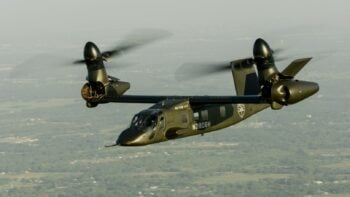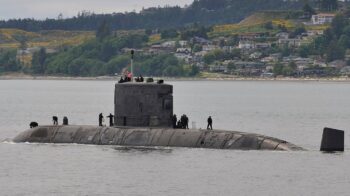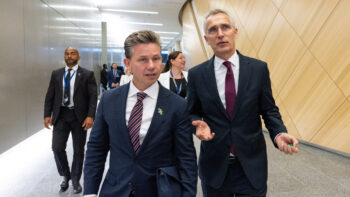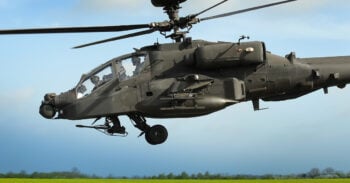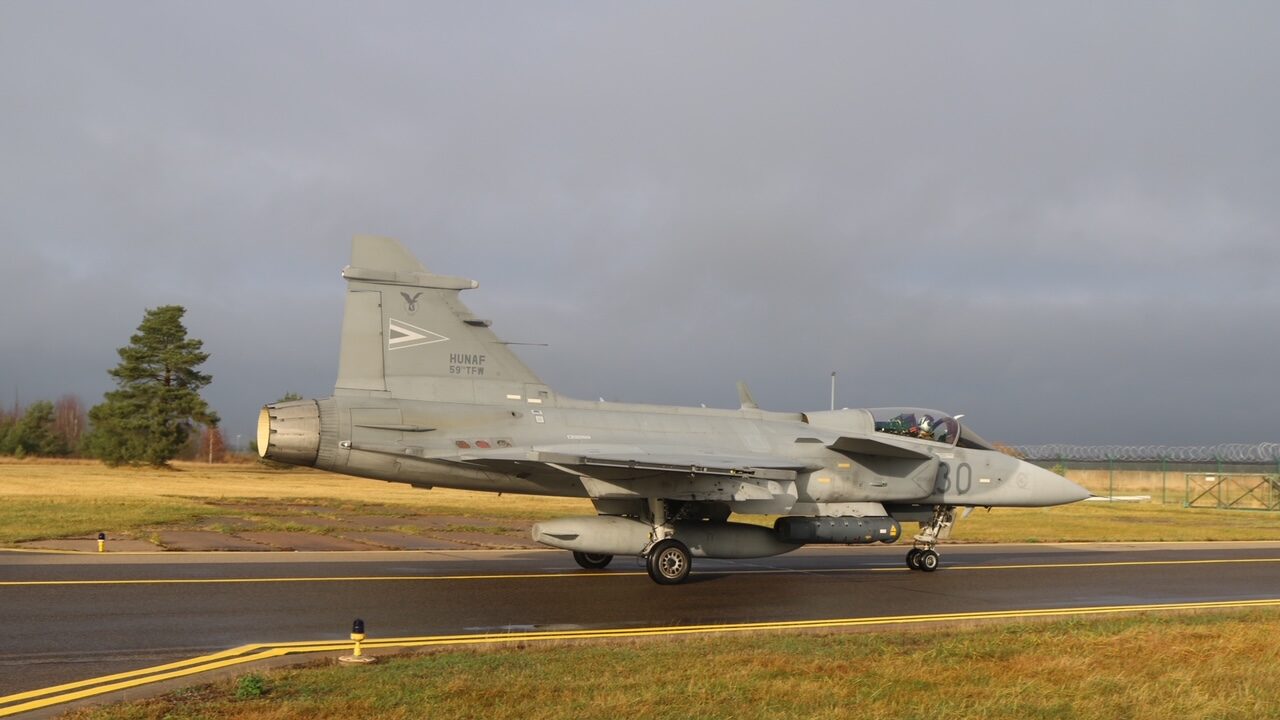
A Hungarian Air Force JAS 39 Gripen C fighter jet prepares to depart on a training mission (Tim Martin/Breaking Defense)
SIAULIAI, LITHUANIA — The lead nation of NATO’s Baltic Air Policing (BAP) mission recently said that Russian Air Force (VKS) operations across the region are attempting to make “life harder” for the alliance.
“In terms of behavior… I would say they [VKS] try to make our life harder but it’s not super aggressive,” said Maj. Jozsep Papp of the Hungarian Air Force’s “Puma” Tactical Fighter Squadron, during a Tuesday press briefing held at Siauliai Airbase, Lithuania. Hungary currently manages BAP, which focuses almost exclusively on scrambling and intercepting Russian aircraft over international airspace.
The scramble rate of Hungarian JAS 39 Gripen C fighter jets has not changed significantly since Russia’s invasion of Ukraine, according to Papp, but interceptions have included Russian Su-24, Su-27, Su-35s, MiG-31 combat jets, IL-20 airlifters, AN-26 and AN-72 transport aircraft.
BAP scrambles are ordered by NATO from Siauliai should Russian aircraft breach an eight nautical mile buffer zone in the Baltics, not share a flight plan, fail to communicate with air traffic control by radio or turn off transponders.
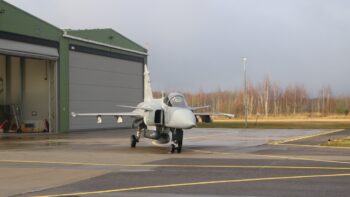
A Hungarian Gripen sits at a NATO airbase in Lithuania. (Tim Martin/Breaking Defense)
Alongside Hungarian Gripens, Polish F-16s are currently on base to support the BAP mission with German Eurofighter Typhoons at Amari Air Base in north western Estonia also complimenting air policing deployments across the region. Under NATO requirements, the BAP lead nation must use two unarmed fighters for deployments and reserve two others equipped with weapons for back up.
The Hungarian Air Force will handover leadership of the BAP rotation to Poland at the end of November, after succeeding Spain in August. Since then it has completed 79 scrambles and amassed 275 flight hours with four Gripen jets, including air-to-air and air-to-ground training flights. Budapest’s other BAP detachments occurred in 2019 and 2015.
Plans are also underway to modernize Hungarian Air Force capabilities after the Hungarian and Swedish governments concluded negotiations for the former’s Gripen fleet (14 aircraft in all) to be upgraded to the MS20 Block 2 standard in January 2022. Breaking Defense accepted travel and accommodation to Siauliai for the event from Saab, which makes the Gripen.
RELATED: Made to take on Russia, Swedish Gripen fighter jets should go to Ukraine, report says
Under the program, new radar capabilities will be introduced through installation of the PS-05/A Mk 4 radar, offering increased air-to-air target tracking range, better detection of small air-to-air targets and better clutter suppression, according to Saab company literature.
MS20 Block 2 also includes improved communication capabilities by strengthening Link 16 (NATO datalink) voice communication and integration of Identification Friend or Foe (IFF) NATO Mode 5 — so other alliance aircraft can be detected easier.
In “the coming years” Hungary will also acquire Meteor Beyond Visual Range Air-to-Air Missiles (BVRAAM) and IRIS-T Infrared Within Visual Range (WVR) Air-to-Air Missiles for Gripen, confirmed Papp, both of which are expected to greatly improve the lethality and survivability of the jet.
He added that the current Gripen loadout consists of two AIM-120 Advanced Medium-Range Air-to-Air Missiles (AMRAAM). two AIM-9 Sidewinder AAMs and a “fully loaded gun”.
An agreement with Embraer for production of two KC-390 tactical transport aircraft will also improve air-to-air refueling. A first delivery to Budapest is expected in 2023.
Hungary has also heavily invested in air defense capabilities, with a $426 million order for National Advanced Surface-to-Air Missile System (NASAMS) signed with Raytheon and Norwegian manufacturer Kongsberg in November 2020. The air defense system uses AMRAAM and AMRAAM-ER missiles, SentinelTM radar and Kongsberg’s Fire Distribution Center and canister launcher, according to the industry partners.
Despite Hungary’s procurement efforts looked at as a sign of its air force becoming increasingly more robust and contribution to the Baltics regarded as critical to European security, it has courted controversy under Prime Minister Viktor Orbán’s leadership by blocking a European Commission $18.7 billion support package for Ukraine in an alleged attempt to put pressure on the European Union to release $13.5 billion of funding for Hungary. The latter funds are reportedly set to be suspended next month because of concern over Budapest not following democratic processes correctly.
Orbán also lost trust with Ukraine after refusing to allow Hungarian arms to be transferred to Kyiv following Russia’s illegal invasion, while his close ties with Moscow and nationalist rhetoric have long irritated NATO members.
Turkey and Hungary were the only two countries in NATO to oppose Finland and Sweden’s applications to join the alliance, but their stances both look to have softened recently.
“I think the average Hungarian person would be quite proud of what we are doing in Lithuania,” said Papp.
Army wraps up FLRAA PDR, incorporating special ops design changes
According to a SOCOM official, the Army included feedback from the command that led to design changes like hardware for a refueling probe and features that will enable special operators to make unique modifications.

















